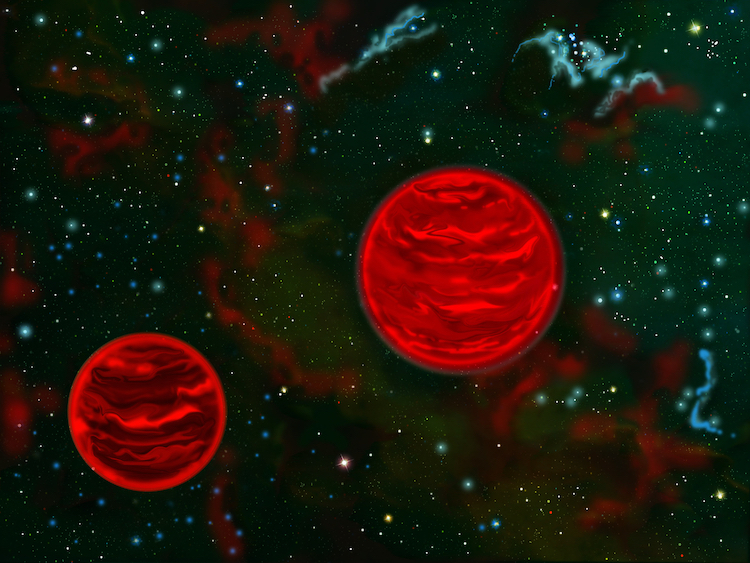The U.S. National Science Foundation National Radio Astronomy Observatory (NSF NRAO), in partnership with several leading Mexican universities and research institutes, has announced a series of landmark agreements and meetings aimed at advancing Mexico’s role in the Next Generation Very Large Array (ngVLA) project.
Recent News
Astronomers Discover a Superheated Star Factory in the Early Universe
Astronomers have uncovered a previously unknown, extreme kind of star factory by taking the temperature of a distant galaxy using the ALMA telescope. The galaxy is glowing intensely in superheated cosmic dust while forming stars 180 times faster than our own Milky Way.
Astronomers Share Largest Molecular Survey To-date: GOTHAM Legacy Data Goes Public
Astronomers in the “GBT Observations of TMC-1: Hunting Aromatic Molecules” research survey, known as GOTHAM, have released a spectral line survey with largest amount of telescope time ever conducted, charting more than 100 molecular species only found in deep space.
Astronomers Discover Jupiter-sized Objects Drawn into Each Other’s Orbit

Credit: Gemini Observatory/Jon Lomberg
VLA & JWST observe binary system of free-floating JuMBOs
In our most basic understanding of our Solar System, planets are drawn into the orbit of our massive star, the Sun. But what happens to planet-sized objects that don’t have a star? A team of astronomers studying Jupiter-mass binary objects (JuMBOs) in the Orion Nebula are gaining a new understanding of these unusual systems. These massive, free-floating objects are being drawn into orbit with each other. These latest findings come from observations made by the Karl G. Jansky Very Large Array (VLA) at the U.S. National Science Foundation National Radio Astronomy Observatory, and NASA’s James Webb Space Telescope.
This groundbreaking discovery has been made in the field of astronomy, thanks to advancements in sensitivity that have allowed scientists to detect fainter and smaller objects in space. Using the VLA, astronomers searched for counterparts to a group of 40 Jupiter-mass binary objects known as JuMBOs, previously identified by Pearson and McCaughrean in 2023. Surprisingly, only one of these objects, JuMBO 24, exhibited a radio counterpart.
This remarkable finding challenges existing theories on the formation of stars and planets. The radio luminosity of the two planets in this binary system is significantly higher than that detected in brown dwarfs, which are objects that share similarities with these planets. This abnormality raises new questions and provides exciting research opportunities to further understand the nature of these free-floating planets. While it is possible that the association between infrared and radio signals is coincidental, the team considers this to be highly unlikely, with odds of only 1 in 10,000. This discovery builds upon the previous work of Kao et al., who, in 2018, detected a single planetary-mass system resembling the components of JuMBO 24 using the VLA.
Dr. Luis F. Rodriguez, Professor Emeritus at the National Autonomous University of Mexico, who participated in this research, emphasizes the significance of the discovery. “What’s truly remarkable is that these objects could have moons similar to Europa or Enceladus, both of which have underground oceans of liquid water that could support life”, he stated.
The detection of radio waves originating from both components of a double system of free-floating planets represents a significant milestone in our exploration of the universe. It also presents an exciting opportunity for further research into the potential habitability of planets beyond our solar system. Read the entire published findings online.
About NRAO
The National Radio Astronomy Observatory (NRAO) is a National Science Foundation facility, operated under a cooperative agreement by Associated Universities, Inc.
NRAO Media Contacts
Corrina C. Jaramillo Feldman
Public Information Officer – New Mexico
VLA, VLBA, ngVLA
Tel: +1 505-366-7267
[email protected]
Jill Malusky
NRAO & GBO News & Public Information Manager
Tel: +1 304-460-5608
[email protected]
This news article was originally published on the NRAO website on February 12, 2024.
Recent News
NSF National Radio Astronomy Observatory and Mexican Institutions Sign Historic Agreements to Advance ngVLA Collaboration
The U.S. National Science Foundation National Radio Astronomy Observatory (NSF NRAO), in partnership with several leading Mexican universities and research institutes, has announced a series of landmark agreements and meetings aimed at advancing Mexico’s role in the Next Generation Very Large Array (ngVLA) project.
Astronomers Discover a Superheated Star Factory in the Early Universe
Astronomers have uncovered a previously unknown, extreme kind of star factory by taking the temperature of a distant galaxy using the ALMA telescope. The galaxy is glowing intensely in superheated cosmic dust while forming stars 180 times faster than our own Milky Way.
Astronomers Share Largest Molecular Survey To-date: GOTHAM Legacy Data Goes Public
Astronomers in the “GBT Observations of TMC-1: Hunting Aromatic Molecules” research survey, known as GOTHAM, have released a spectral line survey with largest amount of telescope time ever conducted, charting more than 100 molecular species only found in deep space.
